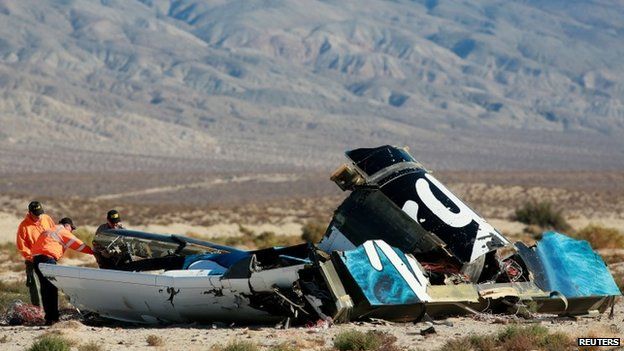Virgin Galactic pilot 'thrown free' from spacecraft
- Published

Some wreckage items were taken back to NTSB labs
The pilot who survived the Virgin Galactic SpaceShipTwo accident was thrown clear as the craft broke up around him, investigators say.
Peter Siebold was interviewed, external about the fatal test flight by a team from the US National Transportation Safety Board.
He parachuted clear as the craft disintegrated over the Mojave desert on 31 October, but co-pilot Michael Alsbury was killed.
It will take investigators at least a year to compile their full report.
Their test was to be one a series that Sir Richard Branson's Virgin Galactic company hoped would finally lead to a commercial passenger service to sub-orbital space being introduced next year.
Mr Siebold, who was interviewed by NTSB investigators on Friday, said he was not aware that his co-pilot had prematurely unlocked the descent braking system.
The NTSB gave no explanation for the crash, but SpaceShipTwo broke apart seconds after igniting its rocket engine, and shortly after the "feathering" system had been unlocked.
Peter Siebold, left, survived the incident but his co-pilot, Michael Alsbury, died
Mr Siebold said he unbuckled from his seat at some point during a fall that began several kilometres up. His parachute subsequently deployed automatically.
Investigators have not revealed the exact altitude of the break-up, but previous SpaceShipTwo test flights flew to about 16km (10 miles) above the Earth.
At this altitude it is highly likely that Mr Siebold lost consciousness for some time due to the lack of oxygen.
In an update, the NTSB said that the on-scene part of the investigation had now concluded and that the wreckage had been recovered and stored at a secure location.
The feathering system had come under scrutiny in previous statements by the NTSB. The spaceship is designed to alter its shape when it re-enters the atmosphere.
The two tails, or feathers, tilt upwards to generate drag during the craft's plunge to Earth.
But simply unlocking the system should not have been enough by itself to cause it to deploy. The pilot must first unlock the system and then activate the feathers in separate procedures.
The feathers are not supposed to be unlocked until the craft reaches a speed of Mach 1.4.
But Michael Alsbury could be seen on in-flight video unlocking the feathers before this, at around Mach 1.0, NTSB Acting Chairman Christopher Hart has previously said.
SpaceShipTwo detached from its "mothership" and fired its rocket, but broke apart seconds later
The feathers engaged despite the fact that the second step to activate them was never taken.
The mechanism may have been deployed by the aerodynamic forces acting on the craft, resulting in the break-up of the ship. This is timed at 10:07:34 - the instant at which video and telemetry were lost.
According to a report, external in the Mail on Sunday newspaper, the father of the surviving pilot, Dr Klaus Siebold, was critical of "a rush" to blame the accident on pilot error.
Dr Klaus Siebold told the newspaper: "'Turning the safety lever won't automatically feather the tail.
"The fact that the tail was feathered without a pilot ordering it to do so suggests a mechanical problem."
One line of inquiry will be to ascertain whether the pilots were getting the correct information on their cockpit display throughout this critical period.
Virgin Galactic has stated its desire to continue with its space venture, despite the fatal accident.
The company has admitted that a handful of its 700 or so customers have asked for refunds in the wake of the crash.
They have paid deposits of some $200,000 (£126,000) a head to reserve seats on the sub-orbital space flights.
It is expected that passengers will experience around five minutes of weightlessness during the two-hour trips.
Follow Paul on Twitter, external.
- Published4 November 2014
- Published3 November 2014
- Published3 November 2014
- Published3 November 2014